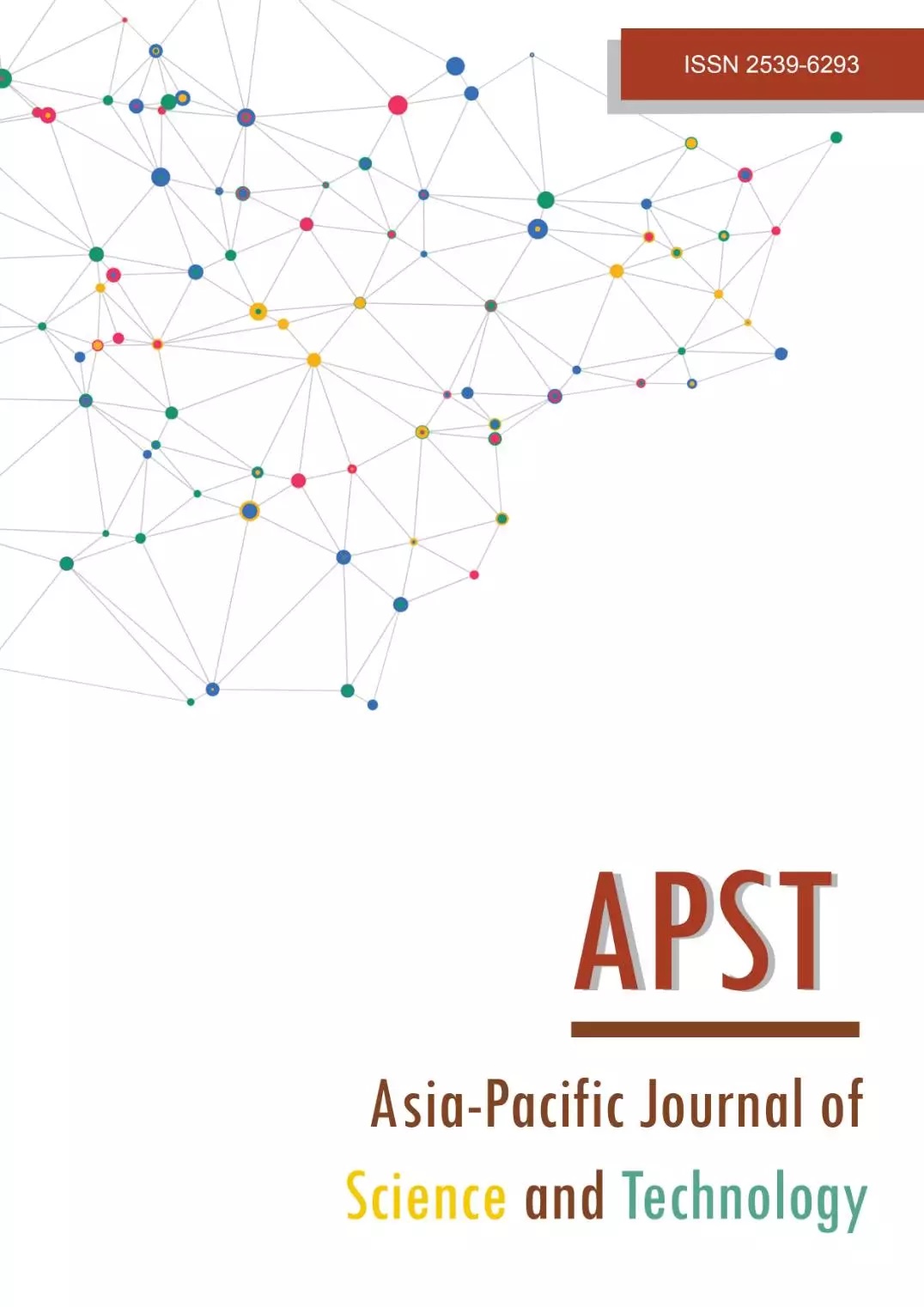Composite flour cracker enriched with banana flour: Formulation optimization and properties
Main Article Content
Abstract
‘Namwa’ banana (Musa sapientum L.) is not only an economical source of dietary fiber which has bio-function properties, but it is also promising for use in snack foods. An extreme vertices mixture design was used to formulate and optimize the composite flour ratios, consisting of banana flour (BF): 20-80%, brown waxy-rice flour (BWRF): 10-60% and cassava starch (CS): 10-60%, for healthy crispy cracker. The pasting properties of individual flour and mixed flour were examined. The textural attributes and chemical properties of crispy crackers were investigated. As banana flour increased, the higher in trough, final viscosity, set back, pasting temperature and peak viscosity of mixed flour were found. The addition of banana flour decreased the peak area and expansion ratio while it increased the density of the crisps. The mixture design proposed regression models to predict the observed attributes. The contours of peak area, count peak, bulk density and expansion ratio were overlaid to acquire an optimal formula region. An optimized formulation for crispy crackers consisted of 33% BF, 14% BWRF and 53% CS. The correlation coefficients between the pasting properties of mixed flour and the physical properties of crackers were very small and mostly negative. Nevertheless, the positive correlations between bulk density with trough and pasting temperature were noted while the pasting temperature provided a negative correlation with expansion ratio and peak count of the crackers. The addition of banana flour in crackers should provide higher dietary fiber and resistant starch in the products as well as healthier food.
Article Details

This work is licensed under a Creative Commons Attribution-NonCommercial-NoDerivatives 4.0 International License.
References
Naknaen P, Charoenthaikij P, Kerdsup P. Physicochemical properties and nutritional compositions of foamed banana powders (Pisang Awak, Musa sapientum L.) dehydrated by various drying methods. WJST. 2016;13(3):177-191.
Falade KO, Okocha JO. Foam-mat drying of plantain and cooking banana (Musa spp.). Food Bioproc Tech. 2012;5(4):1173-1180.
Thuwapanichayanan R, Prachayawarakorn S, Soponronnarit S. Drying characteristics and quality of banana foam mat. J Food Eng. 2008;86(4):573-583.
Thuwapanichayanan R, Prachayawarakorn S, Soponronnarit S. Effects of foaming agents and foam density on drying characteristics and textural property of banana foams. LWT - Food Sci Technol. 2012;47(2):348-357.
Falcomer AL, Riquette RFR, Lima BR, Ginani VC, Zandonadi RP. Health benefits of green banana consumption: a systematic review. Nutrients. 2019;11(6):1222. PMID: 31146437.
Vatanasuchart N, Butsuwan P, Narasri W. Nutritional composition, in vitro starch digestibility and estimated glycemic index of three varieties of ‘Kluai Namwa’ banana (Musa sapientum L.) and its products. Maejo Int J Sci. 2015;9(2):265-277.
Saldivar SS. Snack foods: types and composition. In: Caballero B, Finglas PM, Toldrá F, editors. Encyclopedia of food and health. 1st ed. Massachusetts: Academic Press; 2016. p.13-18.
Farinu A, Baik OD. Deep fat frying of foods-transport phenomena. Food Rev Int. 2005;21(4):389-410.
Farkas BE, Singh RP, Rumsey TR. Modeling heat and mass transfer in immersion frying. I, model development. J Food Eng. 1996;29(2):211-226.
Dobarganes C, Ruiz MG, Velasco J. Interactions between fat and food during deep-frying. Eur J Lipid Sci Technol. 2000;102(8-9):521-528.
Khoozani AA, Birch J, Bekhit AEA. Production, application and health effects of banana pulp and peel flour in the food industry. J Food Sci Technol. 2019;56(2):548-559.
Cornell JA. Experiments with mixtures: designs, models, and the analysis of mixture data. 3rd ed. New Jersey: John Wiley & Sons, Inc.; 2002.
Saeleaw M, Schleining G. Effect of blending cassava starch, rice, waxy rice and wheat flour on physico-chemical properties of flour mixtures and mechanical and sound emission properties of cassava crackers. J Food Eng. 2010;100(1):12-24.
Yu SY. Acceptability of fish crackers (keropok) made from different types of flour. ASEAN Food Journal. 1991;6(3):114-116.
Wang Y, Zhang M, Mujumdar AS. Influence of green banana flour substitution for cassava starch on the nutrition, color, texture and sensory quality in two types of snacks. LWT - Food Sci Technol. 2012;47(1):175-182.
Horwitz W. Official method of analysis of AOAC International. 1st ed. Maryland: AOAC International; 2010.
Zhou M, Robards K, Holmes GM, Helliwell S. Structure and pasting properties of oat starch. Cereal Chem. 1998;75(3):273-281.
Nwokocha LM, Aviara NA, Senan C, Williams PA. A comparative study of some properties of cassava (Manihot esculenta, Crantz) and cocoyam (Colocasia esculenta, Linn) starches. Carbohydr Polym. 2009;76(3):362-367.
Sopade P, Hardin M, Fitzpatrick P, Desmee H, Halley P. Macromolecular interactions during gelatinisation and retrogradation in starch-whey systems as studied by rapid visco-analyser. Int J Food Eng. 2006;2(4):1-15.
Swinkels JJM. Composition and properties of commercial native starches. Starch. 1985;37(1):1-5.
Charles AL, Chang YH, Ko WC, Sriroth K, Huang TC. Influence of amylopectin structure and amylose content on the gelling properties of five cultivars of cassava starches. J Agric Food Chem. 2005;53(7):2717-2725.
Craig SAS, Maningat CC, Seib PA, Hoseney. RC. Starch paste clarity. Cereal Chem. 1989;66(3):173-182.
Hung D, Rooney LW. Starches for snack foods. In: Lucas EW, Rooney LW, editors. Snack food processing. 1st ed. Florida: CRC Press; 2001. p. 115-136.
Kim YS, Lee YT. Physicochemical properties of starches from waxy and non-waxy hull-waxy barleys. J Korean Soc Appl Bi. 1999;42(3):240-245.
steaming time on the linear expansion of fish crackers (‘keropok’). J Sci Food Agric. 1999;79(11):1340-1344.
Huda N, Ikhlas B, Ismail N. The effect of different ratio of Dory fish to tapioca flour on the linear expansion, oil absorption, colour and hardness of fish crackers. Int Food Res J. 2009;16(2):159-165.
Singthong J, Thongkaew C. Using hydrocolloids to decrease oil absorption in banana chips. LWT - Food Sci Technol. 2009;42(7):1199-1203.
Dent JB, Black MJ. Systems simulation in agriculture. London: Applied Science Publishers; 1979.


